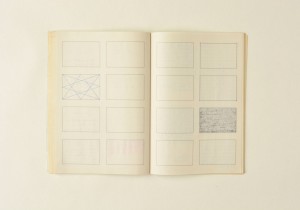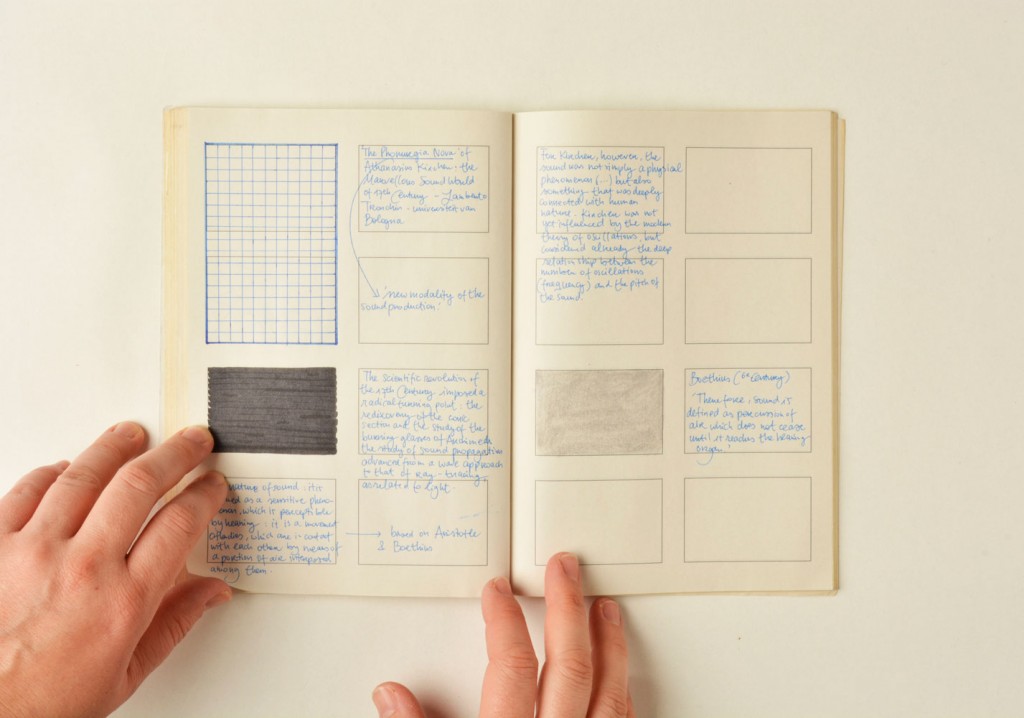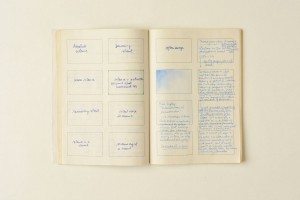On the Process of Becoming Silent and Listening
Esther Venrooy
2015-02-28
For thousands of years sound waves were not able to be captured or recorded. Most of our knowledge of acoustical events in the past comes from graphic notational systems and written witness accounts. For example in his journal German naturalist and explorer Alexander von Humboldt wrote that the sounds of the Orinoco were not as loud during the day as during the night. According to von Humboldt this change in volume was probably caused by the high temperature during the day, creating a density in the air which would mask the water sounds. This sonic rapport is maybe not accurate or even complete, but it gives us a good idea of the acoustical situation.
What is a sound? My thoughts wander off, I quieten down and become more aware of my environment. I listen to the sounds of my surroundings: paper crumpling, a soft humming of the computer, an airplane passing by and voices in the distance. Silence. This process of becoming silent and listening deeply has been the starting point in each of the projects, case studies and works on this topic of research, and it seems I need to approach the first question by raising another question: what is silence?
So it is when there comes to us the excitement of realizing that
musicians everywhere make their sounds to capture silence or that
architects develop complex shapes just to envelop empty space.[1]
Silence is the absence of sound. There is no auditory sensation. We are speaking of absolute silence. How is it to experience absolute silence and is it possible to experience an absence of sound? The philosopher Roy Sorensen points out that ‘hearing silence is a successful perception of an absence of sound (…) Hearing silence does not depend on reflective awareness of the silence. Sometimes we become aware of a lengthy silence only after it has been broken.’[2] Silence, marked in time, can only exist because of its sonic surroundings, an environment filled with cars, machines and people talking. So in order to experience what is not one has to experience what is. Silence doesn’t sound like anything and it has no loudness, timbre or pitch, but we do experience silence as an occurrence in time. This raises yet further questions for Sorensen: ‘If silence is a zero-value sound, then what does it have zero of? (…) Does silence have a zero-value pitch? Is silence very low or very high? Can two silences of equal loudness and pitch differ in timbre?’[3] If silence has a zero value of sound one may consider sound not so much as an energy form without mass, but explore the invisible materiality of sound.
In our daily life we experience the concept of silence. We have these moments and places of silence to commemorate a specific historical event, or we seek out a place (a church, a chapel, a park, a pavilion, etc.) for reflection and introspection. But we human beings do not experience absolute silence, except maybe in space. ‘In space nobody can hear you scream’[4], but even in space or in an anechoic chamber we still hear the sounds of our heartbeats, the tones of our nervous system and blood pressure. And even when we experience absolute silence we seem to fill this void with projections of ourselves. In our present-day culture we are surrounded by the many noises of the city. The main focus in constructing a house or a building is to keep the city noise outside, in an attempt to create silence. But is silence something which we can create, like how we create or produce sounds? Or is it just there when the sound is absent?
The shuffling of wooden benches, a clock ticking, the crackling of wooden floors, a church bell, scissors working through fabric, etc. The audio track of the documentary ‘Die Groβe Stille’[5] consists mostly of sounds from the everyday lives of the monks of the Grande Chartreuse. The Carthusian monks spend most of their days in their cells, devoting their lives to the divine through solitude and silence. The silence of this Catholic monastic order is not so much acoustic silence, but refers to inner silence in order to become closer to the divine. In many religious traditions silence is considered to be the divine truth, the source of perfection and the highest form of expression. Contemplation and spiritual growth can, for example, be reached through silent prayer in Christianity or through meditation in Zen Buddhism. The vow of silence is a common practice in main religions to remain silent for a long period of time. Additionally, the practices of the Naqshbandi Sufis, also known as the ‘silent Sufis’, are done in silence because the divine is considered to be silent emptiness.
‘I am here, and there is nothing to say. If you are among those who wish to get somewhere, let them leave at any moment. What we re-quire is silence; but what silence requires is that I go on talking (…) I have nothing to say and I am saying it and that is poetry as I need it. This space of time is organized. We need not to fear these silences, – we may love them.’[6]
As an electronic composer and musician I have for many years been completely devoted to the creation and organisation of sound, its juxtapositions and meanings, and not so much to the ‘silence’ of the space. For this research project I placed myself in these absences and silences during the initial stage of the creation process, becoming silent and opening myself completely to my sonic, architectural and visual surroundings. This attitude towards sonic surroundings can be an intense mental process, but becoming silent and closing oneself off is something all living beings experience every night: sleep. This naturally reoccurring state is perhaps the only experience which comes close to experiencing absolute silence. Our sensations are reduced or even absent at a certain stage of sleep, our muscles relax, we drift into unconsciousness and our awareness of our surroundings disappears. In several stages of our anabolic state images, memories, emotions and sensations seem to flood into each other, an intense introspection occurs, and we lose our awareness of our external environment.
Morton Feldman, a composer and close friend of John Cage, wrote about the process of becoming silent, losing control and sliding into in a dream: ‘Sound is all our dreams of music. Noise is music’s dreams of us. And those moments when one loses control, and sound like crystals forms its own planes, and with a thrust, there is no sound, no tone, no sentiment, nothing but the significance of our first breath (…).’[7] The creation of an inner silence by listening to music or our surroundings evokes a dreamlike state of mind, where one drifts into a mental space, intensifying the other senses.
 In the early 1950s the American composer John Cage attended a series of lectures on Zen by D.T. Suzuki at Columbia University, where he learned about enlightened receptivity. In the following years he reflected on the concept of receptiveness, emptiness and silence in his lectures, writings and compositions. Silence, according to Cage, is the activity of sounds that constantly surrounds us. We call this silence because it is free of our activity. Silence is the sounds we don’t intend.[8] Since the beginning of the 20th century the main element in composed music has been sound and its organisation. ‘For in this new music nothing takes place but sounds: those that are notated and those that are not. Those that are notated appear in the written music as silences, opening the doors of the music to the sounds that happen to be in the environment. This openness exists in the fields of modern sculpture and architecture.’[9] This silence is about becoming silent as a listener, shifting the focus to the usually inaudible sounds of one’s surroundings, but also about the artist remaining silent. Cage’s silence is not so much an acoustical silence, but the composer leaves room for unintended sounds to enter the composition. For ‘there is no such thing as an empty space or an empty time. There is always something to see, something to hear. In fact, try as we may to make a silence, we cannot.’[10]
In the early 1950s the American composer John Cage attended a series of lectures on Zen by D.T. Suzuki at Columbia University, where he learned about enlightened receptivity. In the following years he reflected on the concept of receptiveness, emptiness and silence in his lectures, writings and compositions. Silence, according to Cage, is the activity of sounds that constantly surrounds us. We call this silence because it is free of our activity. Silence is the sounds we don’t intend.[8] Since the beginning of the 20th century the main element in composed music has been sound and its organisation. ‘For in this new music nothing takes place but sounds: those that are notated and those that are not. Those that are notated appear in the written music as silences, opening the doors of the music to the sounds that happen to be in the environment. This openness exists in the fields of modern sculpture and architecture.’[9] This silence is about becoming silent as a listener, shifting the focus to the usually inaudible sounds of one’s surroundings, but also about the artist remaining silent. Cage’s silence is not so much an acoustical silence, but the composer leaves room for unintended sounds to enter the composition. For ‘there is no such thing as an empty space or an empty time. There is always something to see, something to hear. In fact, try as we may to make a silence, we cannot.’[10]
In music practice and training one is more focused on what is (sound) and not so much what is not (silence). Amateur and professional music students regularly lose themselves in time while waiting for their next musical line. Not saying anything and remaining silent is considered to be a negative experience in our Western society. We prefer to avoid ‘awkward’ silences and keep filling these absences with small talk or elevator music. In ‘Music of Changes’ (1951) John Cage tries to shift the focus from what is to what is not. He breaks the hierarchy by treating silence as an equal to sounds; on the chart used to determine the sounds, 32 of 64 possibilities (the even numbers) are silences, the length of which, just like the lengths of the sounds, is decided upon by another chart.[11] His musical composition ‘4’33’ consists entirely of a succession of silences. Cage builds up the silence of each movement, and the three movements add up to 4’33.[12] In this work Cage has created an experience of silence where the audience is invited to listen to the absence of the intentional composition. Listening to what is, not so much to what is not without any expectation of a big occurrence, while the composer remains silent. The views of American writer Susan Sontag coincide with Cage’s. She states that looking at nothingness or emptiness is still to see something, even when it is only thoughts or reflections of ourselves.[13] She even suggests that art ‘must tend toward anti-art, the elimination of the ‘subject’ (the ‘object’, the ‘image’), the substitution of chance for intention, and the pursuit of silence.’[14]
Being silent as a musician in an orchestra is an important part of the whole musical experience. Waiting for the start of a musical line and attending to notated rests are essential in musical performance. In all compositions there is a silent part. It is not the part of the conductor, but a silent voice. This silent voice is present before the musicians start playing, it follows along in time with the musical composition, it is audible when the musicians remain silent or take a break, and it is still present after the final note. According to Edward Cone this silent part frames the entire musical work, announcing the start and bringing the audience back to reality.[15] These silent parts are always different in length, depending on the actions and dynamics of the sounds in the composition. This silent voice is not always indicated in a musical score, but seems to be an invisible line running under the notated music. In the graphic version, space and time notation of the silent piece ‘4’33’ by John Cage (1953) there is a visual representation of the silent voice. It is indicated as a vertical line, running along time, with some time markings.
The composer and sound artist Jürg Frey suggests there is another concept of silence. He speaks of silence which can be present in a sound. His view of silence seems to be in accordance with becoming and being silent and the view that for silence to appear in sound, one must let go of everything which gets in the way of silence. This again refers to the state of mind of the creator / performer of a musical composition or art work. ‘This sound is a sound without the idea of what it can mean or how it should be used. This sound achieves a hint of permeability, which otherwise belongs only to silence. This sound is the Da-sein (being there) of sound. Its presence and charisma make themselves felt in the composition.’[16]
The absence of a sound, a silent sound which still exists in a particular place and time, is the notion of the afterimage. In my early electronic compositions I strived to create this sensation of the experience of a sound without it being actually present. By meticulously placing a very significant sound in a (horizontal / vertical) composition, this sound would still resonate in the listener’s mind after its disappearance. In this case I am not so much speaking of an echo, which is a reflection of sound, but rather of a memory of a sound.
The character of this sound could be anything – bright, dark, low, high, golden, orange, trembling, flowing, etc. – as long as it stands out from its sonic environment by its introduction and leaves a gap, empty space or silence after its disappearance. Sound artist Max Neuhaus speaks in his writings of the appearance of a sound by taking it abruptly away, creating a sense of silence. ‘In this silent moment, for a few seconds after the sound has gone, a subtle transparent aural afterimage is superimposed on the everyday sounds of the environment, a spontaneous aural memory or reconstruction perhaps, shared by all who notice it, engendered by the sound’s disappearance.’[17]
Neuhaus’s concept is to gradually introduce a sound in an (urban) environment, slowly increasing the volume over time, creating a crescendo and then suddenly taking the sound away so that it appears after its disappearance. ‘The sound I was building is not the thing I was building; I was building the thing that happens when the sound disappears.’[18]
As humans we are always looking for meaning in what we experience and we are always projecting ourselves onto our surroundings, even when we see, hear or experience nothing. In our childhood we would look at the clouds and we would see ships, pirates and faces, and if we held a shell to our ear we would hear the sea. The Surrealists were very aware of the mind projecting itself onto the outside world and creating phantom images. The paranoiac-critical method by Salvador Dalí: a spontaneous method of irrational knowledge based on the critical and systematic objectivity of the associations and interpretations of delirious phenomena. Surrealist poet and writer André Breton speaks about the ‘crisis of the object’: ‘the object is not as a fixed external object but also as an extension of our subjective self.’[19] The brain’s perception of that which is not there or is silent has been an area of research since the late 19th century: parapsychology. The Electronic Voice Phenomenon (EVP) focuses on the auditory perception of phenomena (voices) in empty and silent spaces. The scientific results are highly questionable, but the various recording and listening methods show us that there are a lot of experiences and sounds to be found in sonic absence.[20]
Esther Venrooy
Text #2 in “We Write, Right?” a project by gold extra
Footnotes
1 Charles Moore (1977) Foreword ‘In Praise of Shadows’ by Junichirō Tanizaki
2 Roy Sorensen (2009) ‘Hearing Silence: The Perception and Introspection of
Absences’, Sounds and Perception (126)
3 Ibid. (141)
4 Tagline from the movie ‘Alien’ by Ridley Scott
5 Philip Gröning (2005) ‘Die Groβe Stille, documentary (DVD)
6 John Cage (1959) ‘Lecture on Nothing’, Silence (109-110)
7 Morton Feldman (1958). ‘Sound, Noise, Varèse, Boulez’. Give My Regards to
Eighth Street (1-2)
8 Helen Luckett and Lauren A.Wright (2010) ‘Companion to Cage’ Every Day Is
A Good Day (71) cited from Richard Kostenaletz (2002) ‘Radio and Audio
tape’. Conversing with Cage (166)
9 John Cage (1958) ‘Experimental Music’. Silence (7-8)
10 Ibid. (8)
11 Guy De Bièvre (2009) article ‘Full of Void’ cited from John Cage, I-VI (1990)
The Charles Norton Lectures 1988-89, Weslyan University Press
12 Ibid.
13 Susan Sontag (2002) ‘The Aesthetics of Silence in Styles of Radical Will’
14 Ibid.
15 Guy De Bièvre (2009) article ‘Full of Void’
16 Jürg Frey (1998) ‘The Architecture of Silence’
17 Max Neuhaus ‘Time Pieces’, www.max-neuhaus.info
18 Max Neuhaus (1993) ‘Moment’, www.max-neuhaus.info
19 André Breton
20


